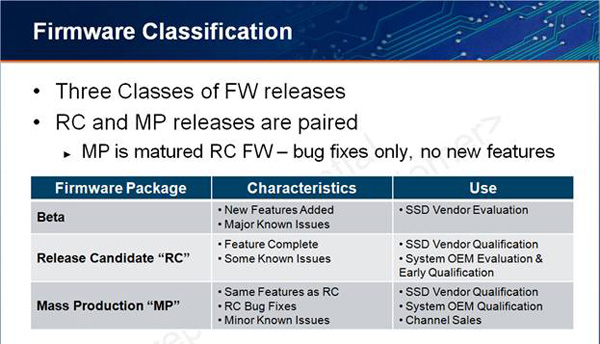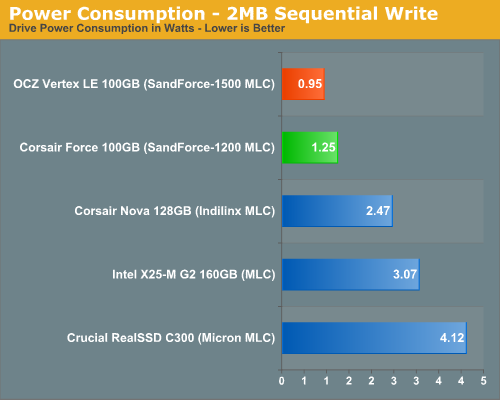Understanding SandForce's SF-1200 & SF-1500, Not All Drives are Equal
by Anand Lal Shimpi on April 16, 2010 11:30 AM ESTIt’s a Mad World: Not All SF-1200s Perform Alike
OCZ was the first from our community to really embrace SandForce. It’s my understanding that the two companies have a very close relationship, and OCZ has committed a lot of resources to SandForce and its products. OCZ took the early risk that others would not. While other companies are working with SF today, OCZ appears to have been the first from the SSD makers we cover on the site.
In exchange for their cooperation and support, SandForce gave OCZ a couple of things. First was the unique SF-1500 used in the Vertex LE at competitive prices (and minus some of the enterprise features). This gave OCZ a huge head start on the competition. The second thing SandForce gave OCZ was the rights to an exclusive firmware for the SF-1200. This firmware would give OCZ the small file random write performance of the SF-1500, but with the rest of the feature set of the SF-1200. This special firmware is going to be used in the upcoming Vertex 2 SSD.
The rest of SandForce’s customers would get the standard SF-1200 firmware, which allows the drive to run at 10,000 sustained 4K random IOPS. Other SF-1200 drives from OCZ, such as the upcoming Agility 2, would also use this standard SF-1200 firmware. The special firmware is only for the Vertex 2 at this point.
SandForce’s firmware has been in release candidate (RC) stage for the past couple of months. Internally SandForce calls this version 3.0.1 and has communicated to all of its partners what RC vs. MP (mass production) firmware entails:

This slide is shared with all SF partners.
Two things are true about this RC firmware: 1) it doesn’t limit small file random write speed on the SF-1200, and 2) there is a known reliability issue that could result in a dead drive (similar to what happened to my Vertex 2 Pro earlier this year).
And here’s where things get messy. SandForce distributed 3.0.1 to all of its partners (so much for that exclusivity agreement), and some of its partners have decided to sample reviewers or even ship based on 3.0.1. Note that even OCZ’s Vertex LE shipped using the SF-1500 version of this firmware. If SandForce indeed distributed the above slide to all of its partners, no drive should've shipped with RC firmware. That's a separate issue entirely and I've been working with both SandForce and the companies involved to see what we can do about curbing this (or at least get me the information so that I can make it clear when a product is using non-MP firmware).
The Corsair Force drive that has been sent out for reviews and that’s currently shipping today uses SandForce’s 3.0.1 firmware.
Naturally, I called up Corsair to figure out what’s going on. Corsair explained to me that the reliability problem was related to a power saving feature on the controller that Corsair simply disabled and thus avoided the issue entirely. I have yet to find a repeatable way to reproduce the bug, but the power data from our testing corroborates what Corsair is saying:

Corsair’s drive uses more power than OCZ’s Vertex LE. While it could be for a number of reasons, it’s apparently due to this power saving feature being disabled. Unless I’m wrong, Corsair appears to have circumvented the known reliability issue and is shipping product it feels is safe into the market.
Now we get to the other problem. The performance of 3.0.1 is the same as OCZ’s exclusive SF-1200 firmware, because the firmwares are the same. However SandForce has recently released its first MP firmware: 3.0.5. This firmware, as you’d expect, caps small file random write performance on all SF-1200 drives except for the Vertex 2 in accordance with SandForce’s agreement with OCZ. The SF-1500 version of this firmware doesn’t change performance, but it does supposedly fix the reliability problems and is available for Vertex LE owners here.
Corsair is currently testing the 3.0.5 revision for its drive but hasn’t shared it with me yet. Corsair wasn’t aware that performance dropped with this revision until I called yesterday. The release notes don’t indicate anything of the sort, Corsair was kept completely in the dark on this. Why didn’t SandForce tell Corsair? Because although it drops performance, the new firmware still runs the SF-1200 at its intended spec. The chip will continue to perform as advertised, just slower than with the RC firmware and slower than OCZ’s Vertex 2.










81 Comments
View All Comments
willscary - Friday, April 16, 2010 - link
Where does the Mercury Extreme fit in? 5 days ago I purchased 3 of these drives. The website touted 10,000,000 hr life, etc. of the Sandforce 1500. Suddenly, this morning, (after my 1st two drives have shipped, but 3rd drive is out of stock) the OWC site lists 2,000,000 hr life.Did OWC switch to the 1200? Am I stuck with a lesser controller? Did OWC always use the 1200 controller and now just change their website after your article appeared?
If so, I will cry "FOUL"!!!
Anand Lal Shimpi - Friday, April 16, 2010 - link
When OWC started shipping the Mercury Extreme there were no SF-1200s as far as I can tell. The early set of drives were almost surely this odd SF-1200/SF-1500 hybrid similar to what OCZ shipped with the Vertex LE.Remember that those controllers were a limited run. I wouldn't be surprised if the newer drives are SF-1200 based, although that's super sketch to change specs without changing the drive's name at all. I'm going to find out for you what's going on asap.
Take care,
Anand
MrSpadge - Saturday, April 17, 2010 - link
Technically they could still go for the "odd SF-1200/SF-1500 hybrid" as the chips are identical anyway. It's a matter of supporting this operation mode in newer firmware, though.yodasz - Monday, April 19, 2010 - link
http://macperformanceguide.com/Reviews-SSD-OWC-Mer...willscary - Monday, April 19, 2010 - link
Nice catch on the post. However, the author can claim whatever he wants about the "flavor" variations...OWC TOLD ME VERBALLY that all current and future Mercury Extreme SSDs were shipping with the Sandforce 1200 controller. This was NOT speculation. While I understand that specifications may have little or no impact on the actual, real world performance, the fact is that I paid for something and in return was sent something that cost them between $100-150 less than the original. This was not labor or process efficiency cost savings. It was not a reduction in R&D. It was a change in the actual product hardware. It would be the same as an auto manufacturer selling me a car with a V6, then actually delivering the same model with a turbocharged 4 cylinder. The overall performance may be nearly the same, but the longevity may be different and the cost would be less for them. If the auto dealer failed to tell me they had switched mortors and also failed to discount the price, I would sue them. What makes this OK for OWC?punjabiplaya - Friday, April 16, 2010 - link
Really good insight. Just looks like business got in the way of the drive's performance. Hopefully SandForce has acknowledged their mistake and will not repeat it. Their controller looks really promising.newsh.it - Sunday, April 18, 2010 - link
yes Anand is a top notch reviewer... keep up the good work!!!Zenthar - Friday, April 16, 2010 - link
I'm probably not the first to say it, but as my first comment ever I felt I had to say it: Anand you're the best. You do a better job investigating the tech industry products and practices than most journalists do for any kind of articles; this article is a clear example of that. People might start reviewing other SF-1200 drives based on the "wrong" F/W and thus review drives better than they should be; I can't but suspect SandForce did this consciously and with that objective in mind.Keep on the good work.
Doraemond - Friday, April 16, 2010 - link
I agree wholeheartedly! Unlike other sites which just rehash and aggregate other news sites, AnandTech really takes the extra effort to go out, investigate, benchmark and analyze technology. You guys really make me come back for more!I remember one of the first magazines I subscribed to was Byte. Though now defunct, I thoroughly enjoyed their very in-depth articles on everything from microprocessor architecture to the run-of-the-mill experiences of an author who loves tech (Jerry Pournelle). I miss that publication greatly but everytime I go to AnandTech, this site really reminds me of how technical and professional Byte was in their journalism and how great a service AT has been to both technical jargon-inclined people such as myself as well as the average Joe.
Thanks guys!
semo - Friday, April 16, 2010 - link
This is obviously a blunder that only a new and inexperienced company can make. Like someone else said, it's probably more like the business unit failing rather than the engineers but it just shows that this market segmentation crap looks really silly unless executed well and come up with sufficient amount of bs to cover it. Intel seems to got the hang of it